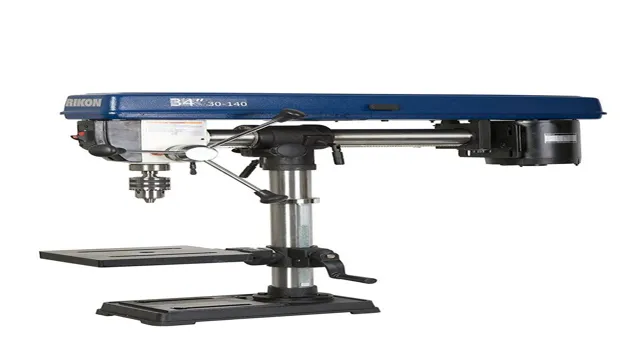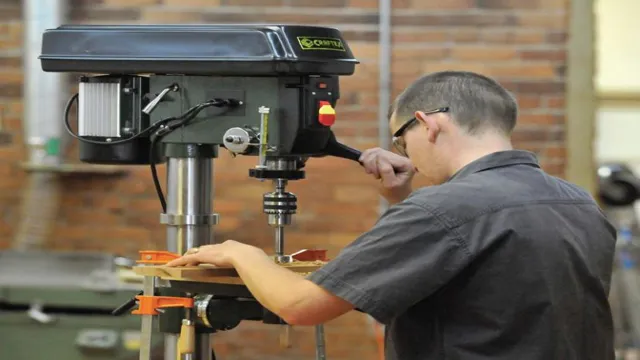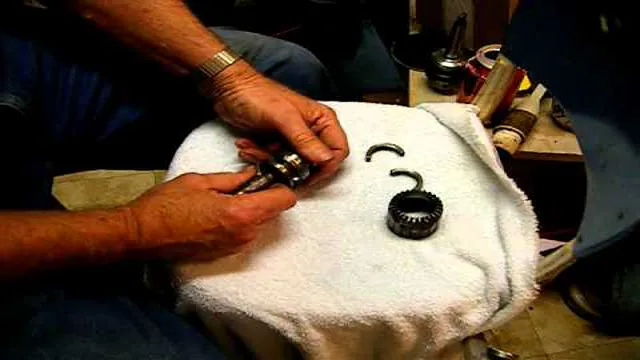
If you are a DIY enthusiast, then a drill press is probably a tool that you have seen or used before. For those who aren’t familiar with it, a drill press is a machine that drills holes in materials such as wood, metal, or plastic. One of the most common questions regarding drill presses is whether or not they need to be mounted.
To put it simply, the answer is yes, drill presses do need to be mounted in most cases. Drill presses are powerful machines that can generate a lot of torque. When you are working with a drill press, there is a lot of force being transferred from the drill bit to the material you are drilling.
If the machine isn’t stable, it can be dangerous to use. This is why drill presses need to be mounted to a bench or a stand. Mounting a drill press also makes it more accurate.
When you mount the machine, you are ensuring that it won’t move or wobble while you are drilling. This means that you will be able to make more precise holes. If you are using a drill press for woodworking or metalworking, accuracy is essential.
Mounting the machine is the best way to ensure that you get the results you want. In conclusion, while there may be some exceptions, drill presses generally need to be mounted. Not only does it make them safer to use, but it also makes them more accurate.
If you are going to use a drill press, it is important to make sure that you have a sturdy surface to mount it on. This will help you get the best results possible and keep you safe while working with this powerful tool.
What is a Drill Press?
If you’re new to woodworking or metalworking, you may be wondering whether a drill press has to be mounted to a workbench or can be used as a standalone tool. The short answer is that most drill presses do need to be mounted for safe and effective use. This is because you’ll be working with materials that require a significant amount of force to penetrate, and a drill press that isn’t firmly anchored to a surface could easily tip over or move around, which could result in dangerous or inaccurate cuts.
However, there are some portable drill presses that are designed to be used without being mounted, so if you’re set on a standalone model, look for one that is specifically marketed as portable or benchtop-sized. Either way, be sure to read the manufacturer’s guidance and use common sense to ensure that you’re using your drill press safely and effectively.
Definition and Functions
A drill press is a machine that uses a rotating drill bit to make precise holes in various materials. It is often used in woodworking, metalworking, and DIY projects. The device has a base, column, and an adjustable head that can move up and down to control the depth of the hole.
The drill bit is held in a spindle, and it rotates at high speeds controlled by a pulley system. The drill press also has variable speed settings that help to adjust its speed according to the material being drilled. One of the significant benefits of using a drill press is the accuracy and precision it provides, ensuring that the holes are consistent in size and depth.
The machine also saves time and energy, making it an essential tool for both hobbyists and professionals. Whether you’re a DIY enthusiast or a seasoned professional, a drill press is an indispensable tool to have in your workshop.

Benefits of Mounting a Drill Press
Many individuals who own a drill press often wonder whether it needs to be mounted or not. The answer is yes, it’s highly recommended to mount your drill press. There are several benefits to doing this, the first of which is improved accuracy.
Mounting a drill press ensures that it stays in place while you work, preventing unwanted movement and increasing precision. Another benefit is safety. Mounting your drill press securely prevents it from tipping over during use, which could cause injury to you or damage to your equipment.
Additionally, mounting your drill press frees up valuable space in your workshop. By affixing it to a dedicated workbench or stand, you’re able to keep your workspace more organized, efficient, and clean. Overall, mounting a drill press is a smart investment that improves efficiency, accuracy, and safety, making it a must-have for any serious woodworker, metalworker, or DIY enthusiast.
Increased Stability and Precision
If you’re a DIY enthusiast or a professional woodworker, a drill press is an essential tool to have in your workshop. Not only does it provide increased stability and precision, but it also ensures that your work is done accurately and efficiently. One of the great benefits of mounting a drill press is that it can handle large projects that require a lot of holes to be drilled.
It’s also excellent for making repeat holes with the same depth and angle, making it perfect for making straight or angled holes. Additionally, mounting your drill press on a sturdy base improves accuracy while minimizing the risk of wobbling or vibrations, which can lead to errors. With a drill press, you’ll be able to drill holes perfectly, whether you’re working on furniture, cabinets, or other wooden items.
Overall, a drill press is an indispensable tool for woodworking, allowing you to take your precision and accuracy to the next level.
Saves Space and Increases Efficiency
Mounting a drill press can bring a multitude of advantages, and one of those is saving space and increasing efficiency. By mounting the drill press, you are freeing up valuable workspace that can be used for other tasks. The drill press will be secure and steady, preventing any unwanted movement during use.
This will allow for more precise and accurate drilling, ultimately saving time and increasing productivity. Additionally, mounting the drill press can help to reduce operator fatigue as it will require less physical effort to use. It’s like having an extra set of hands to hold the workpiece in place.
Overall, mounting a drill press can be a game-changer for any workspace, providing a more organized and productive environment.
When is it Necessary to Mount a Drill Press?
As a power tool used in drilling and creating holes in a variety of materials, a drill press is a handy tool to have around the workshop. But the question is, does a drill press have to be mounted? The answer depends on the size and type of drill press, the nature of the work to be done, and personal preferences. For small, handheld drills, mounting may not be necessary.
However, for larger, heavy-duty drill presses that work with larger materials, mounting is a must to ensure stability and reduce the risk of accidents. A drill press can be mounted on a bench or stand, and some models come with their own mounting stands. Additionally, mounting a drill press can help improve accuracy and precision in drilling.
Ultimately, it is up to the user to decide whether mounting the drill press is necessary for their specific needs and safety considerations.
Size and Power of the Drill Press
When it comes to drilling, a drill press is an essential tool that provides stability and precision. However, not all drilling tasks require the use of a drill press. Generally, it’s necessary to mount a drill press when the workpiece is too large or heavy to be moved around easily.
Mounting the drill press on a sturdy, level surface ensures stability and prevents the drill bit from breaking or veering off course. Additionally, mounting a drill press can increase the power and size of the available tools. This is particularly useful when working with harder materials or large workpieces, which require more force to penetrate.
Therefore, it’s important to consider the size and power of the drill press to maximize the efficiency and safety of your drilling tasks. Overall, mounting a drill press is necessary when it ensures stability, precision, and safety while completing drilling tasks.
Type of Material Being Drilled
Drill Press, Mounting When it comes to drilling, the type of material being drilled is a crucial factor to consider. Certain materials require more precision and stability than others, which is when it becomes necessary to mount a drill press. Mounting a drill press provides a stable base that allows for accurate drilling without the risk of the drill bit wandering off course or breaking.
This is particularly important when working with harder materials like metal and thick wood. When a drill bit spins at high speeds, even the slightest movement can result in poor quality holes or damage to the material being worked on. By mounting the drill press, the operator has better control over the drilling process and can ensure that the holes are straight and accurately sized.
In summary, while it’s not always necessary to mount a drill press, it’s an ideal solution when working with delicate, hard-to-drill materials due to its stability and precision capabilities.
Tips for Mounting a Drill Press
If you own a drill press, you might be wondering if it needs to be mounted. The short answer is yes, a drill press should always be mounted to ensure stability and safety while operating it. Here are some tips to help you properly mount your drill press: First, choose a sturdy workbench or stand that is level and has enough space for your drill press.
Make sure it’s strong enough to hold the weight of your drill press as well as any workpieces you’ll be drilling. Next, attach the drill press to the workbench using bolts or screws. It’s important to follow the manufacturer’s instructions for mounting, as every drill press is different.
Make sure the mounting is secure and stable before using. If you don’t have a dedicated workbench or stand, you can purchase a floor-mounting kit to secure the drill press directly to the ground. This is a good option if you plan on using the drill press often and want maximum stability.
Overall, mounting your drill press is an important step in ensuring the safety and accuracy of your work. By taking the time to do it right, you’ll be able to enjoy the many benefits of your drill press for years to come.
Choosing the Right Mounting Surface
When it comes to mounting a drill press, choosing the right surface is crucial for your safety and the accuracy of your work. The ideal surface should be sturdy, level, and capable of holding the weight of the drill press. A solid workbench or a dedicated stand is often the best option for stability and support.
However, if you plan on using your drill press for heavy-duty tasks, it may be necessary to bolt it to the floor for added stability. Before mounting your drill press, make sure to measure the height of your work surface and adjust the drill press accordingly to ensure comfortable and efficient operation. Remember, a stable mounting surface will not only enhance your workmanship but also prevent potential accidents while working with heavy-duty materials.
So, take your time to choose the right surface and install your drill press in a secure and stable manner.
Proper Alignment and Safety Precautions
Mounting a drill press can be a deceptively simple task, but it is important to take proper precautions to ensure safety and accuracy. The first step is to select a sturdy work surface and ensure that the drill press is properly aligned and bolted securely in place. It is also crucial to follow all manufacturer instructions and safety guidelines, including using appropriate personal protective equipment, such as safety glasses and ear protection.
When drilling, it is important to maintain a firm grip on the workpiece and avoid moving it until the drill has completely stopped. Finally, it is important to regularly inspect and maintain the drill press to ensure that it remains in proper working order. By taking these simple steps, you can help ensure a safe and effective drilling experience every time.
Conclusion
So, to answer the question of whether a drill press must be mounted, the answer is not a straightforward ‘yes’ or ‘no.’ It all depends on your needs and preferences. If you have limited space and need a stable workspace, then mounting the drill press is probably the right choice.
However, if you require flexibility and versatility in your drilling operations, a portable drill press might be a better option. Ultimately, it’s up to you to choose the right tool for the job, and as the old saying goes, ‘A drill press mounted is a tool utilized; a drill press portable is a tool available.'”
FAQs
What is a drill press and how does it work?
A drill press is a machine used for making repetitive drilling operations. It works by rotating a cutting tool, called a drill bit, which is pressed against the workpiece to create a hole.
What are the different types of drill presses available?
There are several types of drill presses available in the market, including bench-top, floor-standing, magnetic, compact, and radial drill presses.
Can a drill press be operated manually or does it require electricity?
Drill presses can be operated both manually and with electricity. Manual drill presses are often used for smaller projects or in areas without electricity, while electric drill presses are better suited for larger projects and commercial use.
Does a drill press need to be mounted to a workbench or stand?
Yes, a drill press should be mounted to either a workbench or stand to ensure stability and accuracy during use.
What size drill press is best for general use?
For general use, a drill press with a minimum of a 12-inch swing and a 3/4 horsepower motor is recommended.
How do I maintain and care for my drill press?
To maintain and care for your drill press, keep it clean and lubricated, ensure the chuck is tight and secure, and regularly check and adjust the belts.
Can a drill press be used for other purposes besides drilling?
Yes, some drill presses can be used for sanding, grinding, and other light machining operations with the appropriate attachments.







